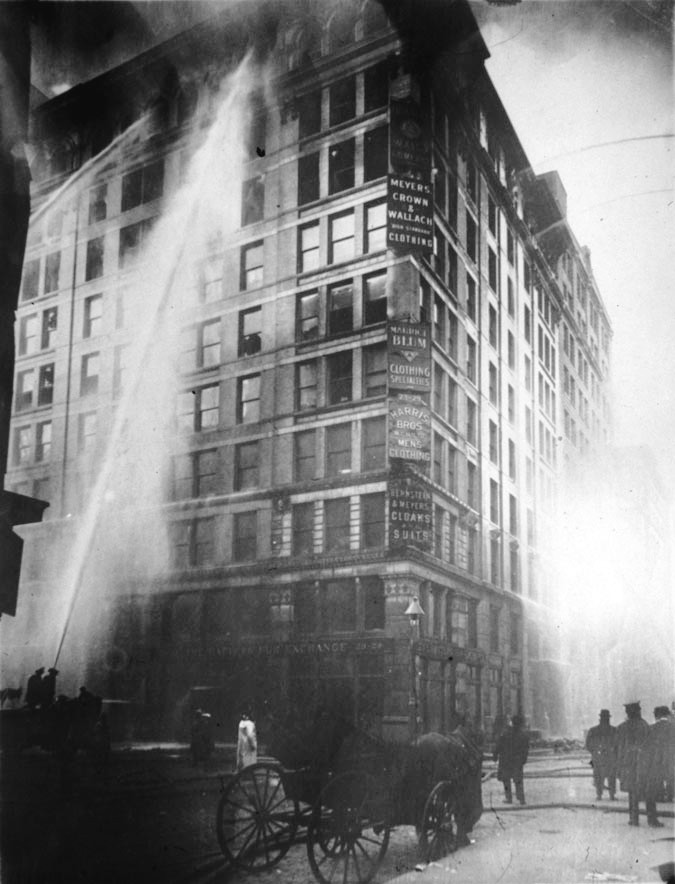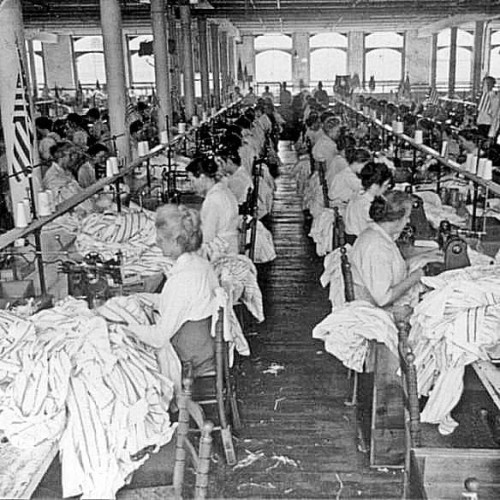The Triangle Shirtwaist Factory Fire
March 24, 2022

By: Kaysey A. Richardson
On March 8, 1911, the first International Women’s Day was commemorated in Europe but following the celebration was tragedy. Days later, on March 25, the Triangle Shirtwaist Factory in New York City caught fire, causing 146 female workers to die as a result. This was one of the most infamous events, not only in American industrial history, but in women’s history, sparking a push toward safer working conditions, fairer wages, and shorter work days.
During the late nineteenth century and early twentieth century, sweatshops were a prominent part of large cities and all held similar negative traits. Crammed and unsanitary workspaces as well as hiring young immigrant women were common occurrences in these factories. The Triangle Shirtwaist Factory was no exception. Owned by Max Blanck and Isaac Harris, the factory was located on the top three floors of the Asch Building on the corner of Greene Street and Washington Place in Manhattan. Although it was well-known that fires were a strong possibility in these sweatshops, there were no precautions set in place to avoid such a disaster due to corruption within the industry.
The owners Blanck and Harris were complicit in this corruption and had ill-famed policies against their workers. Even though the women of the factory worked long twelve-hour days seven days a week, they were only paid $15 per week. Two years prior to the fire,a strike led by the International Ladies Garment Workers Union demanded higher pay and shorter hours. Among the few to resist these conditions were Blanck and Harris. The men went to the extent of hiring undercover police to imprison the striking women and paying politicians to look the other way. Following this strike, the owners began to lock the doors of the factory to keep workers in and labor organizers out.
It was a Saturday afternoon when the fire began in a rag bin. A manager attempted to use a fire hose to extinguish it, but the hose was rotted and the valve was rusted shut, making it unsuccessful. The fire quickly grew and panic spread throughout the factory. The only working elevator could hold a mere twelve people at a time, and the operator was able to make only four trips before the inevitable breakdown from the heat and flames. Trapped, scared, and full of panic, the women began to jump from the windows to escape the fire, falling frantically to their death. As these women began to jump, their bodies landed on fire hoses which made it even more difficult to fight the fire. Those who did not make it out and chose to not jump burned in the fire.
It was over in eighteen minutes.
49 of the workers had burned to death or suffocated by smoke, 36 died in the elevator shaft, and 58 died from jumping out the windows. Later, two more died from their injuries, which brought the total death count to 146 women.
The outcome of the fire was less than ideal, because a grand jury did not vote to indict the owners and management of the factory on manslaughter charges, even though the fire was a clear result of their negligence. Eventually, they would pay $75 to each victim’s family, but never faced imprisonment for the deaths from the fire. Nonetheless, the outrage sparked from the fire led to a rise in the fight for women’s rights and improvement in the workplace. From 1911 to 1914 there would be 36 new laws passed regarding labor reform. Additionally, a Fire Prevention Law was passed the October following the fire, in an attempt to prevent future disasters.
Regardless of the spike in women’s rights and labor reform protests, the Triangle Shirtwaist Factory Fire remains one of the most tragic events in women’s and industrial history. Survivors of the fire later recalled the upsetting experience and for some, such as Sylvia Kimeldorf, it was so traumatizing that they were not even able to attend the funerals of those who were killed. Kimeldorf recalled:
“I never went back to see the building. I didn’t go to the funeral. I was so sick from shock that I had to be sent away to the country to regain my strength. For weeks and weeks, I got sick every time I thought of those girls standing on that ledge.”
Kimeldorf was eighteen when she worked at the Triangle Shirtwaist Factory and watched her best friend plummet out the window to her death.
Among other survivors, Sarah Friedman Dworetz, was on the last ride down the elevator to make it out safely. The elevator broke while she was crammed in it and eventually, she had to make a jump for her life out of the broken elevator:
“It was an old style elevator—a cable elevator—to make it go down, you pulled the cable from the floor. That cable was at the side of the elevator shaft. I reached out and grabbed it. I remember sliding all the way down. I was the first to slide down the shaft. Others must have landed on top of me…I had a broken leg, broken arm. My skull had been injured. One of my hands had been burned by friction.”
Like many others, Dworetz was not aware that there was a fire escape. Additionally, Dworetz was never able to lock doors again, with a lingering fear of becoming trapped.
If you’d like to read more oral histories of the survivors click here
Ultimately, the fire that broke out and the deaths to follow at the Triangle Shirtwaist Factory could have been prevented. It is fitting that we celebrate Women’s History Month in March and one hundred and eleven years later, the tragic fire still holds a significant place in United States history.


Resources and further reading:
https://www.history.com/topics/early-20th-century-us/triangle-shirtwaist-fire
https://trianglefire.ilr.cornell.edu/
https://www.famous-trials.com/trianglefire/964-home
https://flagpole.com/news/street-scribe/2021/03/17/the-triangle-shirtwaist-fire-inspired-women-and-workers-movements/